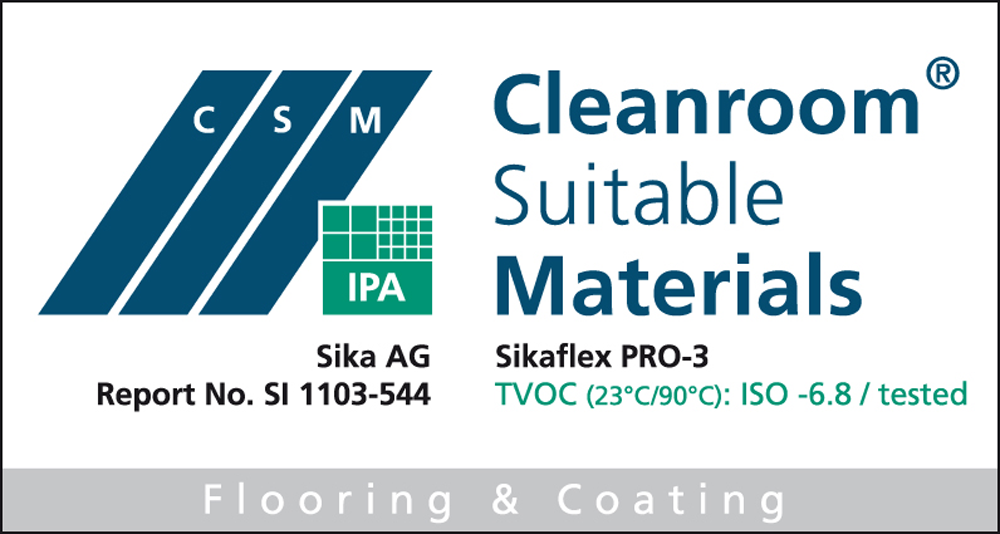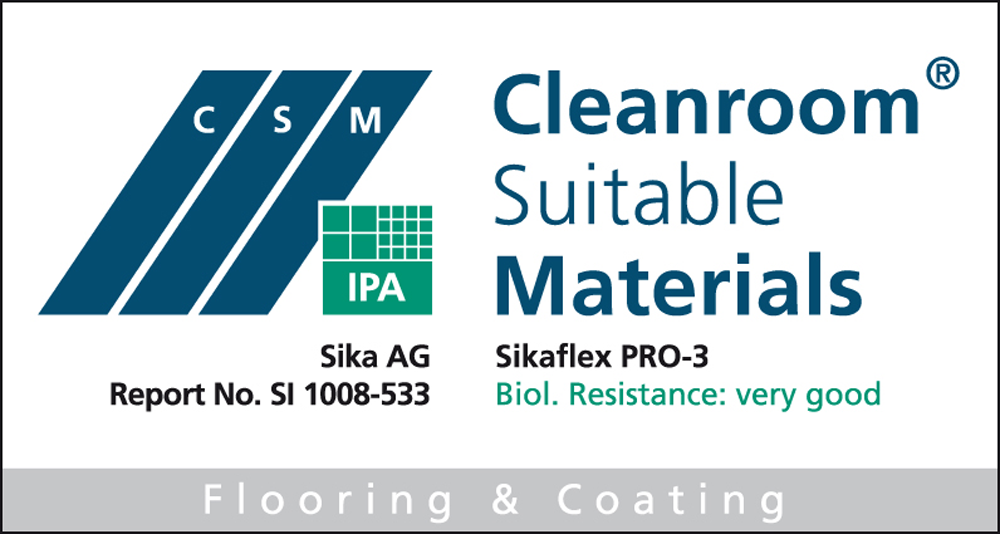
Sikaflex® PRO-3
Sikaflex® PRO-3 is a 1-part, polyurethane, tough, coloured, elastic joint sealant for sealing many types of joint configurations in floors and civil engineering structures. It provides a waterproof seal with good mechanical properties, is resistant to chemicals and remains elastic over a wide range of temperatures.
- Movement capability ±35 %
- Good mechanical and chemical resistance
- Bubble-free curing
- Over-paintable
- Good adhesion to defined construction materials
- Very low emissions
Usage
Horizontal and vertical interior and exterior sealing joint applications:- Food industry
- Cleanrooms
- Sewage treatment plants
- Tunnels
- Floors
- Pedestrian and traffic areas
- Car park parking decks
- Warehouse and production floor areas
Advantages
- Movement capability ±35 %
- Good mechanical and chemical resistance
- Bubble-free curing
- Over-paintable
- Good adhesion to defined construction materials
- Very low emissions
Packaging
| 300 ml cartridge | 12 cartridges per box |
| 600 ml cylindrical foil pack | 20 foil packs per box |
Refer to current price list for packaging variations
Colour
Colour range to be defined by local sales organisation
Product Details
ENVIRONMENTAL INFORMATION
- Conformity with LEED v4 EQc 2: Low-Emitting Materials
- VOC emission classification GEV-Emicode EC1PLUS, license number 3206/20.10.00
APPROVALS / STANDARDS
- CE Marking and Declaration of Performance to EN 15651-4 - Sealants for non-structural use in joints in buildings - Sealants for pedestrian walkways. Classification: PW EXT-INT CC 25 HM
- CE Marking and Declaration of Performance to EN 14188-2 - Joint fillers and sealants - Cold applied joint sealants
- Chemical Resistance. DIN EN 14187, SKZ, Test report No. 127980/17-IV
- Performance Test EN 15651-4, SKZ, Report, 94931/11-I-E
- Biological Resistance, ISO 846, Fraunhofer, Certificate, No SI 1103-544
- Cold applied sealants, EN 14188-2, SKZ, Report, No 94931/11-IV
- Determination of staining, ASTM C 1248-04, SKZ, Report, No 98947/11-V
- Determination of staining, ISO 16938-1, SKZ, Report, No 98947/11-II
- ISO 11600 F-class 25 HM, SKZ, Report, No 94931/11-II
- Standard specification for elastic joint sealants, ASTM C920-11 Class 35, ASTM, Report, No 0314920-SIKA
- Migration behaviour EN 1186, EN 13130, CEN/TS 14234, ISEGA, Certificate No. 48644 U 18
- Outgassing TVOC, CSM procedures, Fraunhofer, Certificate, No SI 1103-544
- Resistance against diesel and jet fuel, DIBt Guidelines, SKZ, Test report No. 94931/11-V
- Sealants in waste water systems, DIBt Guidelines, SKZ, Report, No 94931/11-III
|
|
|
Chemical Base
Polyurethane i-Cure® Technology
Shelf Life
15 months from date of production
Storage Conditions
The product must be stored in original, unopened and undamaged sealed packaging in dry conditions at temperatures between +5 °C and +25 °C. Always refer to packaging.
Density
| ~1,35 kg/l | (ISO 1183-1) |
Product Declaration
EN 15651-4: PW EXT-INT CC 25 HM
EN 14188-2 - Joint fillers and sealants - Cold applied joint sealants
Shore A Hardness
| ~37 (after 28 days) | (ISO 868) |
Secant Tensile Modulus
| ~0,60 N/mm2 at 100 % elongation (+23 °C) | (ISO 8339) |
| ~1,10 N/mm2 at 100 % elongation (−20 °C) |
Elastic Recovery
| ~90 % | (ISO 7389) |
Tear Propagation Resistance
| ~8,0 N/mm | (ISO 34) |
Movement Capability
| ± 25 % | (ISO 9047) |
| ± 35 % | (ASTM C 719) |
Chemical Resistance
For chemical resistance refer to the following report: Chemical Resistance. DIN EN 14187, Sikaflex® PRO-3 (SL), SKZ, Report, 127980/17-IV
For resistance against water and salt water refer to the following report: Performance Test EN 15651-4, Sikaflex® PRO-3, SKZ, Report, 94931/11-I-E
Service Temperature
−40 °C to +70 °C
Joint Design
The joint width must be designed to suit the movement capability of the sealant. The joint width must be ≥ 10 mm and ≤ 40 mm. A width to depth ratio of 1:0,8 must be maintained (for exceptions, see table below).
Typical joint widths for joints between concrete elements for interior applications
| Joint distance [m] | Minimum joint width [mm] | Minimum joint depth [mm] |
| 2 | 10 | 10 |
| 4 | 10 | 10 |
| 6 | 10 | 10 |
| 8 | 15 | 12 |
| 10 | 18 | 15 |
Typical joint widths for joints between concrete elements for exterior applications
| Joint distance [m] | Minimum joint width [mm] | Minimum joint depth [mm] |
| 2 | 10 | 10 |
| 4 | 15 | 12 |
| 6 | 20 | 17 |
| 8 | 28 | 22 |
| 10 | 35 | 28 |
All joints must be correctly designed and dimensioned in accordance with the relevant standards and codes of practice before their construction. The basis for calculation of the necessary joint widths are the type of structure, dimensions, technical values of the adjacent building materials, joint sealing material and the specific exposure of the building and the joints.
For larger joints, contact Sika ® Technical Services for additional information.
Application
Backing Material
Use closed cell, polyethylene foam backing rod
Sag Flow
| 0 mm (20 mm profile, +50 °C) | (ISO 7390) |
Ambient Air Temperature
+5 °C min./+40 °C max.
Substrate Temperature
+5 °C min./+40 °C max. Minimum +3 °C above dew point temperature
Curing Rate
| ~3,5 mm/24 hours (+23 °C / 50 % r.h.) | (CQP* 049-2) |
* Sika Corporate Quality Procedure
Skin Time
| ~60 minutes (+23 °C / 50 % r.h.) | (CQP 019-1) |
Tooling Time
| ~50 minutes (+23 °C / 50 % r.h.) | (CQP 019-2) |
Consumption
| Joint length [m] per 600 ml | Joint width [mm] | Joint depth [mm] |
| 6 | 10 | 10 |
| 3,3 | 15 | 12 |
| 1,9 | 20 | 16 |
| 1,2 | 25 | 20 |
| 0,8 | 30 | 24 |
SUBSTRATE PREPARATION
The substrate must be clean, dry, sound and free from oils, grease, dust, cement laitance and loose or friable particles.
Removal techniques such as wire brushing, grinding, grit blasting or other suitable mechanical tools can be used.
Damaged joint edges can be repaired with suitable Sika repair products
Where joints in substrate are saw cut: after sawing, all slurry material must be flushed away and joint surfaces allowed to dry.
All dust, loose and friable material must be completely removed from all surfaces before application of any activators, primers or sealant.
For optimum adhesion, joint durability and critical, high performance applications such as joints on multi-storey buildings, highly stressed joints, extreme weather exposure or water immersion / exposure, the following priming and/or pre-treatment procedures must be followed:
Non-porous substrates
Aluminium, anodised aluminium, stainless steel, PVC, galvanised steel, powder coated metals or glazed tiles: slightly roughen surface with a fine abrasive pad. Clean and pre-treat using Sika® Aktivator-205 applied with a clean cloth.
Before sealing, allow a waiting time of > 15 minutes (< 6 hours).
Other metals, such as copper, brass and titanium-zinc: clean and pre-treat using Sika® Aktivator-205 applied with a clean cloth. After a waiting time of > 15 minutes (< 6 hours). Apply Sika® Primer-3 N applied by brush. Before sealing, allow a waiting time of > 30 minutes (< 8 hours)
PVC has to be cleaned and pre-treated using Sika® Primer-215 applied with a brush. Before sealing, allow a waiting time of > 30 minutes (< 8 hours).
Porous substrates
Concrete, aerated concrete and cement-based renders, mortars and bricks surfaces must be primed using Sika® Primer-3 N or Sika® Primer-210 applied by brush.
Before sealing, allow a waiting time of > 30 minutes (< 8 hours).
Adhesion tests on project specific substrates must be performed and procedures agreed with all parties before full project application.
Note: Primers and activators are adhesion promoters and not an alternative to improve poor preparation / cleaning of the joint surface. Primers also improve the long-term adhesion performance of the sealed joint.
Contact Sika® Technical Services for additional information.
MIXING
1-part ready to use
CLEANING OF TOOLS
Clean all tools and application equipment with Sika® Remover-208 immediately after use. Hardened material can only be removed mechanically. For cleaning skin, use Sika® Cleaning Wipes-100.


